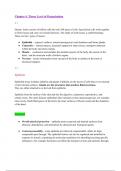Summary
Histology exam preparation with a Summary Fundamentals of Anatomy and Physiology (Hardback), Global Edition - Cell Biology
- Course
- Institution
- Book
This document fully prepares you for the histology exam and meets most of the following learning objectives of the course: Epithelial tissue: * Able to recognise and name different types of epithelia * Able to explain the relation between shape and function of different types of epithelia * ...
[Show more]




